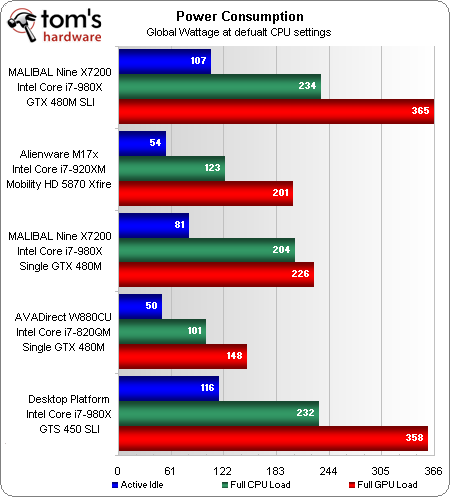Is That A Notebook? MALIBAL's Six-Core, Dual-GPU, Speed Demon
Combining top-end desktop and notebook components, the MALIBAL Nine X7200 is the workstation you can take with you. Today we see how it compares to our fastest “desktop replacement” notebook, and how well it stands up to a similarly-configured desktop PC.
Energy, Efficiency, And Battery Life
Our power consumption numbers shed light on the energy-saving attributes of Intel’s mobile processors, with the CrossFire-equipped M17x drawing less power than the single-card equipped X7200. The tradeoff is, of course, lower performance for the mobile parts.
There is no perfect way to compare desktop and notebook platform energy, since the power supplies can never be the same. This is particularly true with the 80 PLUS Gold-rated OCZ Z1000M power supply our desktop used, which exhibits increased efficiency as load is increased. The MALIBAL Nine X7200 uses a fanless power supply that gets somewhat warm at high loads, which should result in increased efficiency as load is decreased. It appears the desktop platform’s two low-cost GeForce GTS 450 graphics cards use about the same amount of power as the notebook’s dual high-end GTX 480M modules.
And therein is the snag for both Nvidia and power users. Nvidia’s failure is that its $800 GeForce GTX 480M is neither more efficient nor more powerful than the $130 desktop GeForce GTS 450 at the resolutions supported by most notebook panels. Power users, on the other hand, must face the fact that Intel’s Core i7-980X draws big power no matter where it’s installed, resulting in a notebook that’s 2.8” thick and reaches 43 db at full load (one meter), realistically sounds closer to 50db when you’re sitting in front of it, uses a power brick that’s larger than a red facing brick, and has a combined weight greater than that of most bowling balls.
But the woes of power users don’t end at portability and noise. Those hoping to combine the X7200’s CPU and twin graphics processors in some super-duty GPU-assisted encoding tasks should consider themselves lucky if their programs can’t take full-advantage of the GeForce GTX 480M’s capabilities. A few seconds into our attempt to run eleven threads of Prime95 and one thread of FurMark across both graphics processors simultaneously pushed at-the-wall power consumption beyond 400 W, activating the power adapter’s overload protection circuit. Performance slowed to a crawl as the system went into battery-powered mode.
The good news that followed this test was that no combination of real-world programs and games was able to create the same phenomena, with Crysis and Prime95 pulling a maximum of 372 W from the wall (below the 400+ W required to trip the automatically-resetting circuit breaker).
Get Tom's Hardware's best news and in-depth reviews, straight to your inbox.
Current page: Energy, Efficiency, And Battery Life
Prev Page Performance Analysis Next Page As Good As “It” Gets-
compton I'm not sure how awesome this is in practice. I'm sure someone out othere needs this, but that person would have to be blind to appreciate the asthetics.Reply -
iam2thecrowe its more of a portable pc than a notebook. look at the power consumption. Even its own power adaptor cant keep up at max load.Reply -
Darkerson In this case, its not really about looks, as much as its about "portable" brute strength. And it seems to have plenty of that...Reply -
thats actually really good performance from a top end systemReply
at most rates it is still fairly close to a desktop in price also -
maxiim This quite useless if you want all that power for gaming, you surely cant have it on the go with a battery provided....might as well build a with almost the same specs for less money.Reply -
compton Its the same price as a base model Kia Rio just about. Kudos to them for the engineering needed to make this gear work in a mobile chassis. I may not be sold on the concept, or see the need of, but I hope they sell a ton of them. It is kinda cool just because its so powerful -- but for the price you could build or buy two highly specialized systems. It could be a mobile workstation or for AV production work on site instead of just for gaming. Clearly these ultra powerful 'notebooks' are a niche segment, but there are quite a few now. Someone must be buying them.Reply -
sudeshc Not that impressive to me main reason for Lappy is portability and thats where this lacks i wounder even if under no load how much heat it would generate and also the battery wont last long..Reply -
Crashman comptonIt could be a mobile workstation or for AV production work on site instead of just for gaming. Clearly these ultra powerful 'notebooks' are a niche segment, but there are quite a few now. Someone must be buying them.Actually, that's what the X7200 is! Tom's Hardware got the "gaming" version simply to show off its capabilities to enthusiasts, but the Quadro versions are equally viable (and likely more valuable) in their own respective markets.Reply


